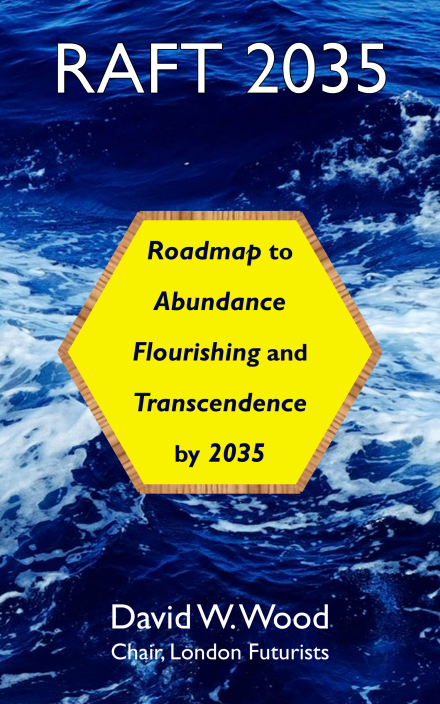This page contains the opening portion of Chapter 7 of RAFT 2035.
Copyright © 2020 David W. Wood. All rights reserved.
7. International conflict
Goal 7 of RAFT 2035 is that risks of international military conflict will have been reduced by at least 90%.

Goal 7 can be seen as an international version of Goal 6. Both these goals address the risks to human flourishing from violence and other crime. Goal 6 is for a 90% reduction of crime at local and national levels. Goal 7 considers the threat of violence and warfare at the international level.
In a world with ever more people having access to ever more powerful weapons, escalating conflict could bring civilisation to an end. Alongside possible attacks from other countries, we also need to consider threats from terrorist groups, international crime syndicates, and other sub-state organisations.
Some of these groups may initiate actions for reasons we might judge to be deluded, misinformed, hasty, suicidal, or mad in some other way. However, these actions may still take place, despite the various sorts of insanity that would be involved. It would be like a repeat of the cascade of unintended consequences that led Europe in 1914 into the horrors of the first world war, following a period in which many people thought, wrongly as it turned out, that large-scale war had become a thing of the past.
However, the increased spread of nuclear technology, chemical weapons, biological pathogens, and cyberattack capabilities, means that a similar cascade of actions in our time could have consequences that are even more devastating than the carnage of the first world war.
This state of affairs is sometimes given the semi-whimsical name “Moore’s Law of Mad Scientists”, on a suggestion from researcher Eliezer Yudkowsky:
The minimum IQ required to destroy the world drops by one point every 18 months.
This is a threat that deserves very serious attention, to prevent international society from sleepwalking into disaster.
Building trust
One response to the threat of attack is to increase spending on defence budgets. Unfortunately, this would mean that significant portions of national resources are tied up in military forces, preventing their deployment on other uses that would be more productive. Moreover, when a potential attacker perceives that it is facing stronger defences, it can prompt further spending on increased aggressive capability, ratcheting an arms race. Any short-term perceived gains in security would likely be illusory.
It would be far better to deescalate current and future threat situations, through measures to build and sustain mutual trust. That is what RAFT envisions.
One factor that can reduce pressures towards conflict is an increased general understanding of the scale of abundance that lies ahead, as humanity takes fuller advantage of green technologies, nanotechnology, robotics, artificial intelligence, and other technological breakthroughs. These technologies have the potential to allow every person on earth to have a significantly higher standard of living than was available even to royalty only a few decades ago. This understanding should reduce the pressures on different groups to compete against each other for a larger slice of the pie. The pie will be large enough for everyone.
However, the mere fact of material abundance is insufficient, by itself, to prevent conflict and strife. There are other causes of conflict, including differences in ideology, inertia from runaway arms races, the perception of inflammatory insults, and other aspects of emotional immaturity. These are all factors that need to be handled better. Happily, these are all factors that can be handled better, via RAFT initiatives.
<snip>

